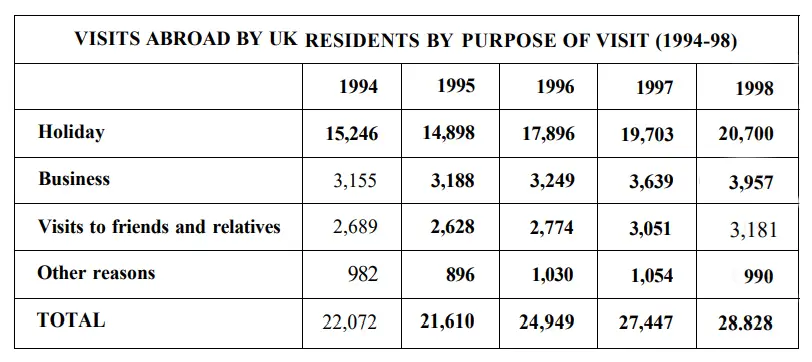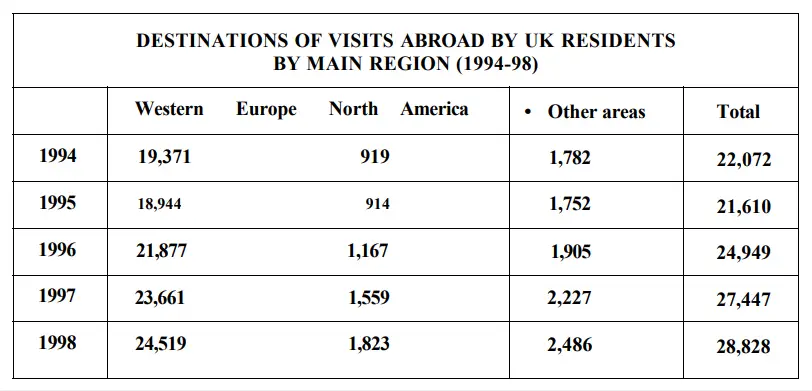ACADEMIC WRITING TASK 1
You should spend about 20 minutes on this task.
The first chart below shows the results of a survey which sampled a cross-section of 100000 people asking if they travelled abroad and why they travelled for the period 1994-98. The second chart shows their destinations over the same period.
Write a report for a university lecturer describing the information shown below.
You should write at least 150 words.


Sample Answer 1 (Band Score 7)
According to statistical information, the main reason for travelling abroad is holidays, business, and visits to friends and relatives. Indeed, there is a steady increase in the number of holidaymakers; while in 1996 there were about 17,896 of the sample in 1998 there were 20,700 of them. Moreover, with the introduction of more countries within the EC market, travelling for business has also increased.
Although there is not a big decrement 3,957 travelled abroad for business during 1998 compared with 3,249 in 1996. Finally, traveling abroad for visiting friends and relatives shows a steady increase over
the period 1994—1998. While there were about 2,628 travellers in 1995 in 1998 the number increased to 3,181 in 1998. Consequently, there is a steady increase in the three main reasons for travelling abroad; Holidays, business, or to visit relatives and friends.
In addition, there is also an Increased change in the destinations which people tend to prefer for travelling. The area which appears to be more popular among travellers in Western Europe. Indeed, while in 1994 only 19,371 of the sample preferred to spend their holiday (or other reasons) in that main region, there was an increase to 24,519 in 1998. North America and other areas appeared also favourable. In 1996, there were 1,167 going to North America and 1,905 to other areas. These numbers increased to 1,823 and 2,486 accordingly. Statistical figures prove that Western Europe seems to be the most favourable place for holidaymakers while North America and other areas follow behind.
Model Answer 2:
The given table compares the figures of research on why 100 thousand of the UK residents visited overseas from 1994 to 1998, and the given bar chart illustrates which countries they travelled during this time.
As a whole, the majority of UK citizens travelled abroad for entertainment, and Western Europe was their most favourable destination. By looking at the table, it can be seen that generally there was a growing tendency for the UK people to travel into other countries from 1994 to 1998. During the second year, in 1995, the total number of travellers marginally declined from just over 22000 to nearly 21500; however, it steadily grew and reached the peak of approximately 29000 in the year 1998.
These people gradually became more interested in traveling to all three regions during this period, but Western Europe was the best option. In 1994, just below 20,000 of the UK citizens went into Western Europe, compared with only almost 1000 into the North America. Furthermore, after a small drop in 1995, the population of Western Europe visitors remarkably increased and reached the maximum of above 24000 in 1998, which was far more significant than the other two locations.
In conclusion, the most proportion of the UK citizens had a trip to Western Europe to spend their holidays and for business trips.
Sample Answer 2:
The provided charts show the data of a survey conducted on 100,000 people and the statistics shows the number of UK citizen travelled abroad from 1994 to 1998 for different purposes and their destinations. As is observed from the given graphs, most of the UK residents travelled on their holidays and Western Europe was their most favourite destination.
Initially, in 1994, more than 22 thousand UK resident travelled to different foreign countries and among them, more than 15 thousand went on their holidays. For business tours, more than 3 thousand people travelled in other countries in the same year while more than 2 thousand people visited their friends and relatives. After 1 year, this number slightly decreased and for the rest of the years until 1998, the number steadily increased in almost all of the categories. Finally, in 1998, the total traveller number reached more than 28 thousand and among them, more than twenty thousand people travelled to enjoy their holidays.
In 1994, almost 18 thousand people out of 22 thousand went to Western Europe which is significantly larger than the number of people travelled to North America and other parts of the world. The similar trends can be observed for the remaining years and the majority people of the UK went to Western Europe which makes this place the most popular tourist’s destination of UK people.
Sample Answer 4:
The supplied charts depict an outcome of a survey conducted among 100,000 people and the survey asks the reason behind the journey and preferred destinations between the periods of 1994 and 1998.
In the first graph, in 1994, the holiday was the most significant reason behind the United Kingdom citizen’s travel and it accounted for 15.246 people whereas, 982 people were travelled because of unspecified reasons. Interestingly, in the case of business and visit to friends and relatives, almost an equal number of people visited 3115 and 2689 respectively. In the number of holiday goers, though, there was a slight decrease in the figure in 1995, the rest of the years there was a gradual increase in the account and reached above 20 thousand. In spite of some downward trends in the initial year (1995), there was a marginal increase in all the categories.
From the year 1994 to 1998, it is clearly seen the trend that North America and other areas obtained a rock bottom position with less than 2000 people. On the contrary, the number of visitors to Europe at a zenith level with around 20,000 per year, besides it showed a gradual hike in the total number of visitors to all the three destinations.

Be First to Comment